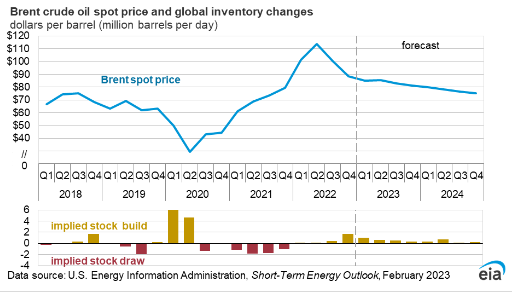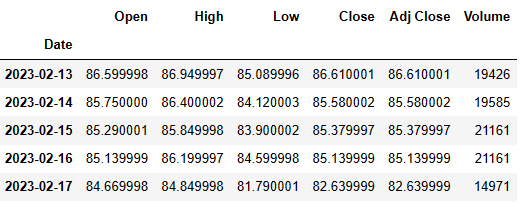Based on our previous study, our today’s focus is on SARIMAX time-series X-validation of the Brent crude oil spot price USD: viz. the goal is to verify the following EIA energy forecast in 2023

According to EIA, the Brent spot price will average $83.63/b in 2023.
Table of Contents
- Prerequisites
- Libraries
- Input Data
- ETS Decomposition
- ADF Test
- SARIMAX
- Predictions
- Residuals
- Summary
- Explore More
- Embed Socials
Prerequisites
In this study we will be installing Anaconda, managing relevant Python-3 packages, creating individual conda environments and sharing them via conda YAML file. One can install multiple packages at the same time.
Libraries
Let’s set the working directory YOURPATH
import os
os.chdir(‘YOURPATH’)
os. getcwd()
and import/install the following libraries
!pip install statsmodels !pip install yfinance
import yfinance as yf
import numpy as np
import pandas as pd
from matplotlib import pyplot as plt
from statsmodels.tsa.stattools import adfuller
from statsmodels.tsa.seasonal import seasonal_decompose
from statsmodels.tsa.arima_model import ARIMA
from pandas.plotting import register_matplotlib_converters
register_matplotlib_converters()
from pmdarima import auto_arima
import warnings
warnings.filterwarnings(“ignore”)
!pip install pmdarima
Additional libraries can be imported on the “if-needed” basis.
Input Data
let’s load the input data
df = yf.download(‘BZ=F’, ‘2022-02-03’)
[*********************100%***********************] 1 of 1 completed
Let’s explore the data structure
df.shape
(264, 6)
df.info()
<class 'pandas.core.frame.DataFrame'> DatetimeIndex: 264 entries, 2022-02-03 to 2023-02-17 Data columns (total 6 columns): # Column Non-Null Count Dtype --- ------ -------------- ----- 0 Open 264 non-null float64 1 High 264 non-null float64 2 Low 264 non-null float64 3 Close 264 non-null float64 4 Adj Close 264 non-null float64 5 Volume 264 non-null int64 dtypes: float64(5), int64(1) memory usage: 14.4 KB
df.describe()

df.tail()

Let’s drop the following columns
df=df.drop([‘Open’, ‘High’, ‘Low’, ‘Close’,’Volume’], axis=1)
to get the single-column table with the time index
df.tail()

Let’s check the null values
df.isnull().sum()
df.isnull().sum()
Adj Close 0 dtype: int64
ETS Decomposition
Let’s perform the seasonal decomposition of our data with model=’multiplicative’ and period=30 (i.e. 1 month)
result = seasonal_decompose(df, model=’multiplicative’,period=30)
result.plot()

ADF Test
Let’s perform the Augmented Dickey-Fuller (ADF) test
adfuller(df[‘Adj Close’])
(-0.8702493547662872,
0.7976118156481764,
10,
253,
{'1%': -3.4564641849494113,
'5%': -2.873032730098417,
'10%': -2.572894516864816},
1257.2890699767)
Here’s how to interpret the most important values in the output:
- Test statistic: -0.870249
- P-value: 0.79761
Since the p-value is not less than .05, we fail to reject the null hypothesis.
This means the time series is non-stationary in that it has some time-dependent structure and does not have constant variance over time.
SARIMAX
Let’s fit auto_arima function to our input dataset
stepwise_fit = auto_arima(df[‘Adj Close’], start_p = 1, start_q = 1,
max_p = 3, max_q = 3, m = 12,
start_P = 0, seasonal = True,
d = None, D = 1, trace = True,
error_action =’ignore’,
suppress_warnings = True,
stepwise = True)
stepwise_fit.summary()
Performing stepwise search to minimize aic ARIMA(1,0,1)(0,1,1)[12] intercept : AIC=inf, Time=1.00 sec ARIMA(0,0,0)(0,1,0)[12] intercept : AIC=1755.936, Time=0.02 sec ARIMA(1,0,0)(1,1,0)[12] intercept : AIC=1388.994, Time=0.28 sec ARIMA(0,0,1)(0,1,1)[12] intercept : AIC=1574.287, Time=0.28 sec ARIMA(0,0,0)(0,1,0)[12] : AIC=1754.679, Time=0.03 sec ARIMA(1,0,0)(0,1,0)[12] intercept : AIC=1438.019, Time=0.05 sec ARIMA(1,0,0)(2,1,0)[12] intercept : AIC=1357.220, Time=1.05 sec ARIMA(1,0,0)(2,1,1)[12] intercept : AIC=inf, Time=3.20 sec ARIMA(1,0,0)(1,1,1)[12] intercept : AIC=inf, Time=0.87 sec ARIMA(0,0,0)(2,1,0)[12] intercept : AIC=1738.787, Time=0.72 sec ARIMA(2,0,0)(2,1,0)[12] intercept : AIC=1358.635, Time=1.18 sec ARIMA(1,0,1)(2,1,0)[12] intercept : AIC=1358.655, Time=1.28 sec ARIMA(0,0,1)(2,1,0)[12] intercept : AIC=1570.019, Time=0.87 sec ARIMA(2,0,1)(2,1,0)[12] intercept : AIC=1360.622, Time=2.68 sec ARIMA(1,0,0)(2,1,0)[12] : AIC=1355.364, Time=0.30 sec ARIMA(1,0,0)(1,1,0)[12] : AIC=1387.045, Time=0.09 sec ARIMA(1,0,0)(2,1,1)[12] : AIC=inf, Time=1.39 sec ARIMA(1,0,0)(1,1,1)[12] : AIC=inf, Time=0.78 sec ARIMA(0,0,0)(2,1,0)[12] : AIC=1740.760, Time=0.18 sec ARIMA(2,0,0)(2,1,0)[12] : AIC=1356.815, Time=0.38 sec ARIMA(1,0,1)(2,1,0)[12] : AIC=1356.832, Time=0.36 sec ARIMA(0,0,1)(2,1,0)[12] : AIC=1572.157, Time=0.30 sec ARIMA(2,0,1)(2,1,0)[12] : AIC=1358.807, Time=0.81 sec Best model: ARIMA(1,0,0)(2,1,0)[12] Total fit time: 18.091 seconds
SARIMAX Results:
| Dep. Variable: | y | No. Observations: | 264 |
|---|---|---|---|
| Model: | SARIMAX(1, 0, 0)x(2, 1, 0, 12) | Log Likelihood | -673.682 |
| Date: | Fri, 17 Feb 2023 | AIC | 1355.364 |
| Time: | 10:36:45 | BIC | 1369.482 |
| Sample: | 0 | HQIC | 1361.045 |
| – 264 | |||
| Covariance Type: | opg |
| coef | std err | z | P>|z| | [0.025 | 0.975] | |
|---|---|---|---|---|---|---|
| ar.L1 | 0.9165 | 0.019 | 47.894 | 0.000 | 0.879 | 0.954 |
| ar.S.L12 | -0.6100 | 0.049 | -12.357 | 0.000 | -0.707 | -0.513 |
| ar.S.L24 | -0.4017 | 0.052 | -7.708 | 0.000 | -0.504 | -0.300 |
| sigma2 | 11.9008 | 0.874 | 13.617 | 0.000 | 10.188 | 13.614 |
| Ljung-Box (L1) (Q): | 0.61 | Jarque-Bera (JB): | 14.30 |
|---|---|---|---|
| Prob(Q): | 0.44 | Prob(JB): | 0.00 |
| Heteroskedasticity (H): | 0.24 | Skew: | -0.01 |
| Prob(H) (two-sided): | 0.00 | Kurtosis: | 4.17 |
let’s split the data into train / test sets
train = df.iloc[:len(df)-12]
test = df.iloc[len(df)-12:] # set one year(12 months) for testing
and fit the SARIMAX(1, 0, 0)x(2, 1, 0, 12) model to the training set
from statsmodels.tsa.statespace.sarimax import SARIMAX
model = SARIMAX(train[‘Adj Close’],
order = (0, 1, 0),
seasonal_order =(2, 1, 0, 12))
result = model.fit()
result.summary()
SARIMAX Results:
| Dep. Variable: | Adj Close | No. Observations: | 252 |
|---|---|---|---|
| Model: | SARIMAX(0, 1, 0)x(2, 1, 0, 12) | Log Likelihood | -647.761 |
| Date: | Fri, 17 Feb 2023 | AIC | 1301.521 |
| Time: | 10:37:05 | BIC | 1311.951 |
| Sample: | 0 | HQIC | 1305.724 |
| – 252 | |||
| Covariance Type: | opg |
| coef | std err | z | P>|z| | [0.025 | 0.975] | |
|---|---|---|---|---|---|---|
| ar.S.L12 | -0.6397 | 0.047 | -13.476 | 0.000 | -0.733 | -0.547 |
| ar.S.L24 | -0.4151 | 0.048 | -8.736 | 0.000 | -0.508 | -0.322 |
| sigma2 | 12.8359 | 0.969 | 13.246 | 0.000 | 10.937 | 14.735 |
| Ljung-Box (L1) (Q): | 0.01 | Jarque-Bera (JB): | 19.35 |
|---|---|---|---|
| Prob(Q): | 0.92 | Prob(JB): | 0.00 |
| Heteroskedasticity (H): | 0.25 | Skew: | -0.40 |
| Prob(H) (two-sided): | 0.00 | Kurtosis: | 4.14 |
- Goodness of fit test, The Jarque-Bera test is a goodness-of-fit test that measures if sample data has skewness and kurtosis that are similar to a normal distribution. The JB test statistic is always positive, and if it is not close to zero, it shows that the sample data do not have a normal distribution.
- Negative skew refers to a longer or fatter tail on the left side of the distribution.
- Positive excess values of kurtosis (>3) indicate that a distribution is peaked and possess thick tails. Leptokurtic distributions have positive kurtosis values.
- A leptokurtic distribution has a higher peak (thin bell) and taller (i.e. fatter and heavy) tails than a normal distribution.
Predictions
Let’s print our test data and 1Y predictions
print(test[‘Adj Close’],predictions)
Date 2023-02-02 82.169998 2023-02-03 79.940002 2023-02-06 80.989998 2023-02-07 83.690002 2023-02-08 85.089996 2023-02-09 84.500000 2023-02-10 86.389999 2023-02-13 86.610001 2023-02-14 85.580002 2023-02-15 85.379997 2023-02-16 85.139999 2023-02-17 83.680000 Name: Adj Close, dtype: float64 252 84.005361 253 85.602957 254 86.011120 255 84.965660 256 84.457512 257 84.003784 258 84.321574 259 85.826474 260 85.605278 261 86.496948 262 86.800109 263 85.527856 Name: Predictions, dtype: float64
Let’s plot test data vs predictions
x=test[‘Adj Close’]
y=predictions
plt.plot(x,y, ‘o’, color=’green’)
get m (slope) and b(intercept) of a linear regression line
m, b = np.polyfit(x, y, 1)
use red as a color for the linear regression line
plt.plot(x, m*x+b, color=’red’)
plt.xlabel(‘Adj Close Test’)
plt.ylabel(‘Predictions’)

Train the model on the full dataset
model = model = SARIMAX(df[‘Adj Close’],
order = (0, 1, 1),
seasonal_order =(2, 1, 1, 12))
result = model.fit()
Forecast for 1Y
forecast = result.predict(start = len(df),
end = (len(df)-1) + 1 * 12,
typ = ‘levels’).rename(‘Forecast’)
Plot the forecast values vs train data
df[‘Adj Close’].plot(figsize = (2, 5), legend = True)
forecast.plot(legend = True)

Let’s plot the forecast
print(forecast)
264 82.930292 265 82.569673 266 82.759312 267 81.629149 268 82.420565 269 82.121951 270 82.551539 271 82.931898 272 82.737850 273 82.810189 274 83.249728 275 83.419509 Name: Forecast, dtype: float64
a = np.array([‘Jan’, ‘Feb’, ‘Mar’,’Apr’,’May’,’Jun’,’Jul’,’Aug’,’Sept’,’Oct’,’Nov’,’Dec’])
plt.plot(a,forecast)
plt.xlabel(“Month 2023”);
plt.ylabel(“Predicted Brent Oil Price $”);

Overall, this plot supports the EIA energy forecast in 2023 within the confidence intervals defined below.
Residuals
Let’s evaluate our predictions by using the following sklearn error metrics
from sklearn.metrics import mean_squared_error
from statsmodels.tools.eval_measures import rmse
rmse(test[“Adj Close”], predictions)
2.5038953839620026
mean_squared_error(test[“Adj Close”], predictions)
6.2694920938262255
Summary
- The ADF test show that our time series dataset is non-stationary. In other words, it has some time-dependent structure and does not have constant variance over time.
- The seasonal decomposition of our dataset reveals the distinct trend curve and the prominent seasonal effect.
- Our train/test dataset does not have a normal distribution – negative skew refers to a longer or fatter tail on the left side of the distribution; positive excess value of kurtosis (>3) indicates that our distribution is peaked and possess thick tails (Leptokurtic distribution).
- Our predictions ca. $83.4 (Dec 2023) are generally consistent with the EIA energy forecast in 2023 (ca. $83.63/b).
- Remaining discrepancies are well within the predicted confidence intervals +/- $6.
Explore More
SARIMAX X-Validation of EIA Crude Oil Prices Forecast in 2023 – 1. WTI
OXY Stock Analysis, Thursday, 23 June 2022
Energy E&P: XOM Technical Analysis Nov ’22
Embed Socials
Your message has been sent
Make a one-time donation
Make a monthly donation
Make a yearly donation
Choose an amount
Or enter a custom amount
Your contribution is appreciated.
Your contribution is appreciated.
Your contribution is appreciated.
DonateDonate monthlyDonate yearly
Leave a comment